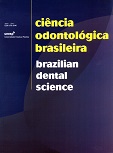Própolis, sálvia, calêndula e mamona – atividade antifúngica de extratos naturais sobre cepas de Candida Albicans
DOI:
https://doi.org/10.14295/bds.2008.v11i2.472Abstract
Plantas medicinais têm sido usadas como tratamento alternativo e coadjuvante de várias doenças humanas. O objetivo foi avaliar in vitro a atividade antifúngica de extratos naturais (própolis, mamona, sálvia e calêndula) sobre 20 cepas de Candida albicans isoladas da cavidade bucal. Para determinação da concentração fungicida mínima (CFM), foram realizadas diluições seriadas dos extratos e suspensões padronizadas de cada cepa de C. albicans (106 céls/mL). Em placas de 24 poços, alíquotas de 1 mL de cada diluição dos extratos foram distribuídas e contaminadas com 0,1 mL de uma suspensão de Candida. As placas foram incubadas (37ºC/24 h) e, a seguir, amostras foram semeadas em duplicata em ágar Sabouraud (37ºC/48 h). Os resultados demonstraram que o extrato glicólico de própolis apresentou capacidade fungicida para todas as cepas de C. albicans, com CFM de 3,12% para 90% das cepas. O extrato glicólico de sálvia apresentou capacidade fungicida para 80% das cepas, com CFM variando de 5 a 50%. O extrato glicólico de calêndula demonstrou atividade fungicida apenas para 10% das cepas. O extrato da mamona não apresentou atividade fungicida para nenhuma cepa. Concluiu-se que o extrato de própolis foi o mais efetivo, apresentando atividade antifúngica para todas as cepas de C. albicans avaliadas.
Downloads
Downloads
Published
How to Cite
Issue
Section
License
Brazilian Dental Science uses the Creative Commons (CC-BY 4.0) license, thus preserving the integrity of articles in an open access environment. The journal allows the author to retain publishing rights without restrictions.
=================




























